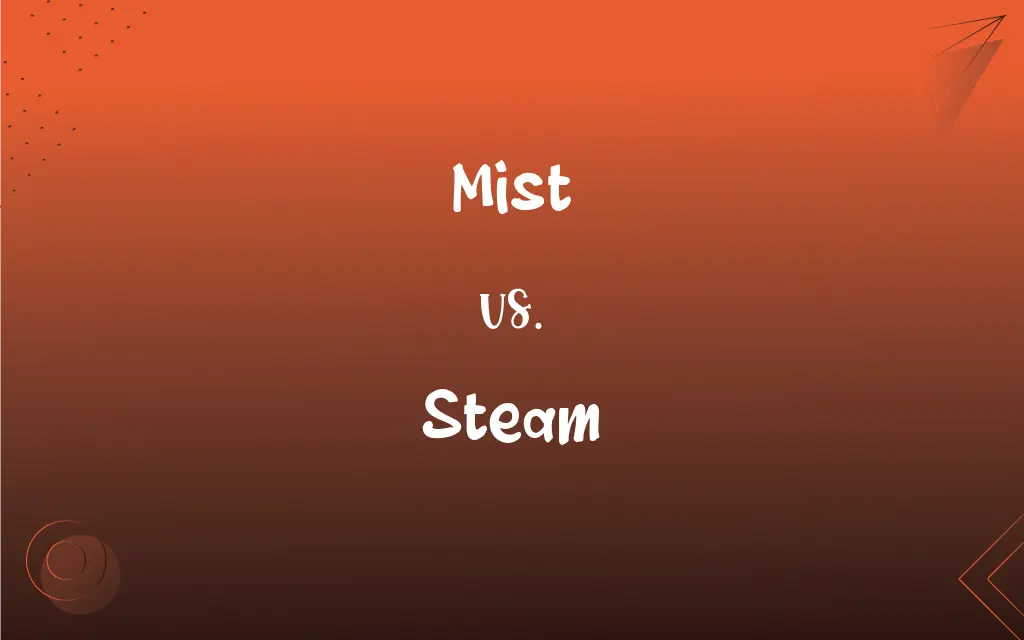Mist vs. Steam: What's the Difference?
Edited by Aimie Carlson || By Janet White || Published on January 15, 2024
Mist is fine droplets of water suspended in air, often seen in cool, damp conditions; steam is water vapor from heated water, visible at higher temperatures.

Key Differences
Mist and steam are both forms of water, but their appearance and conditions of formation differ significantly. Mist is a collection of tiny water droplets suspended in the air, often forming in natural settings like valleys or rivers during cooler temperatures. It gives a translucent, ethereal appearance and is commonly seen in the early morning or evening. On the other hand, steam is essentially water vapor, created when water is heated to its boiling point. Steam is less visible when it first evaporates but becomes visible as it cools and condenses into tiny water droplets.
The physical properties of mist and steam also highlight their differences. Mist, being made up of minute water droplets, tends to linger in the air and can reduce visibility, often associated with damp, cool weather. It's not hot to the touch and doesn't rise rapidly unlike steam. Steam, however, is hot and rises quickly due to the thermal energy it contains. It is initially invisible as it is purely water in its gaseous state but becomes visible as it cools down and condenses back into water droplets.
From an environmental perspective, mist and steam play different roles. Mist often forms in natural settings and can contribute to the ecological balance, providing moisture to plants and animals. It's a common occurrence in certain climates and can influence the weather patterns of an area. Conversely, steam is more commonly associated with human activities, such as cooking or industrial processes. It's a byproduct of boiling water and can be used for purposes like heating, propulsion, or energy generation.
Interaction with mist and steam can offer contrasting experiences. Mist typically cools the surrounding air and can create a mystical, serene environment. It's often associated with peaceful landscapes and can be a refreshing presence. Steam, due to its heat, is usually avoided in close contact as it can cause burns. It's often seen billowing from kettles, radiators, or industrial stacks, symbolizing energy and activity.
Both mist and steam originate from water, their formation, properties, and implications are distinct. Mist forms in cool conditions and adds a damp, ethereal quality to the environment, whereas steam is a product of heat, often associated with human activities and symbolizes energy and transformation.
ADVERTISEMENT
Comparison Chart
Composition
Tiny water droplets suspended in air.
Water vapor, turning into droplets as it cools.
Temperature
Forms in cool, damp conditions.
Produced by heating water to boiling point.
Visibility
Visible as a fine, translucent haze.
Initially invisible, becomes visible when cooling.
Environment
Common in natural settings, especially mornings/evenings.
Often associated with human activities like cooking.
Physical Interaction
Cool and damp, reduces visibility.
Hot and can cause burns, rises due to heat.
ADVERTISEMENT
Mist and Steam Definitions
Mist
A fine spray of water particles causing reduced visibility.
Driving through the mist required extra caution.
Steam
The hot vapor rising from boiling water.
Steam fogged up the kitchen windows.
Mist
A cloud of tiny water droplets in the air.
The mountain was veiled in a light mist.
Steam
Water in its gaseous state due to heat.
The pot on the stove was emitting steam.
Mist
Tiny droplets of water suspended in the atmosphere.
Mist hung over the lake at dawn.
Steam
Water vapor released in industrial processes.
The factory chimneys released steam into the sky.
Mist
A very light form of rain composed of fine droplets.
We felt a gentle mist on our faces during the walk.
Steam
Used in heating systems and engines.
The old train ran on steam power.
Mist
A layer of fine droplets creating a hazy appearance.
The forest was shrouded in a mystical mist.
Steam
A method of cooking food over boiling water.
Vegetables were being cooked by steam in the steamer.
Mist
A mass of fine droplets of water in the atmosphere near or in contact with the earth.
Steam
Hot water vapor produced especially by boiling liquid water.
Mist
Water vapor condensed on and clouding the appearance of a surface.
Steam
Hot, pressurized water vapor used for heating, cooking, or to provide mechanical power.
FAQs
Is mist visible?
Yes, mist is visible as a fine, translucent haze.
What is mist?
Mist is a collection of tiny water droplets in the air, often seen in cool, damp conditions.
What is steam?
Steam is water vapor produced from boiling water, visible when it cools and condenses.
How is mist formed?
Mist forms when water vapor condenses into tiny droplets in cool air.
How is steam generated?
Steam is generated by heating water until it turns into vapor.
Does mist affect visibility?
Yes, mist can reduce visibility by creating a light haze.
Is steam safe to touch?
No, steam can cause burns due to its high temperature.
Can mist be warm?
Mist is typically cool, as it forms in lower temperatures.
What are common uses of steam?
Steam is used in cooking, heating, and industrial processes.
Is steam always visible?
No, steam is initially invisible; it becomes visible when cooling.
Where is mist commonly found?
Mist is common near water bodies and in valleys during cooler temperatures.
Is steam hot?
Yes, steam is hot as it comes from boiling water.
Does mist have a smell?
Mist can carry the scents of its environment but is generally odorless.
Can steam be used for cleaning?
Yes, steam is effective for cleaning and sterilizing.
Can mist affect weather?
Mist can influence local weather by adding moisture to the air.
Is mist dangerous?
Mist isn't dangerous but can impair visibility, affecting travel.
Is mist a form of precipitation?
Mist is similar to very light rain but doesn't always reach the ground.
How long does steam last?
Steam lasts until it cools and condenses back into water.
What happens when steam condenses?
When steam condenses, it turns back into liquid water.
Does steam rise or fall?
Steam rises due to the heat causing it to be less dense than air.
About Author
Written by
Janet WhiteJanet White has been an esteemed writer and blogger for Difference Wiki. Holding a Master's degree in Science and Medical Journalism from the prestigious Boston University, she has consistently demonstrated her expertise and passion for her field. When she's not immersed in her work, Janet relishes her time exercising, delving into a good book, and cherishing moments with friends and family.
Edited by
Aimie CarlsonAimie Carlson, holding a master's degree in English literature, is a fervent English language enthusiast. She lends her writing talents to Difference Wiki, a prominent website that specializes in comparisons, offering readers insightful analyses that both captivate and inform.






































































